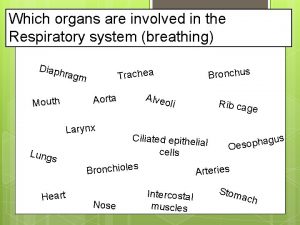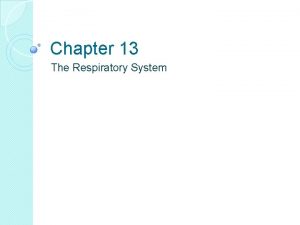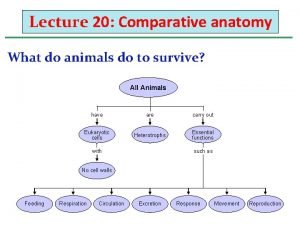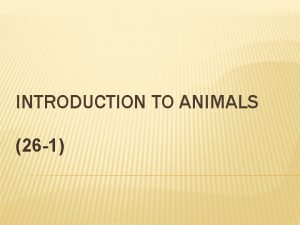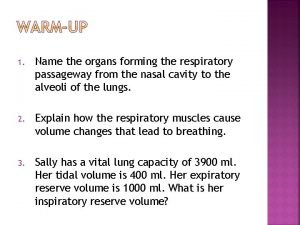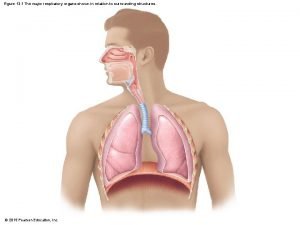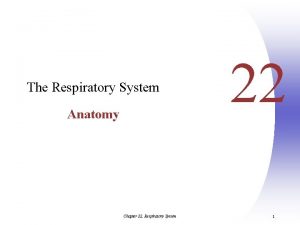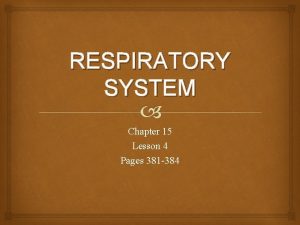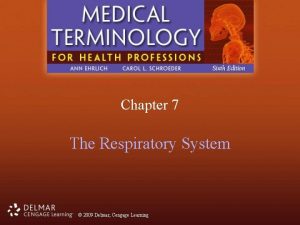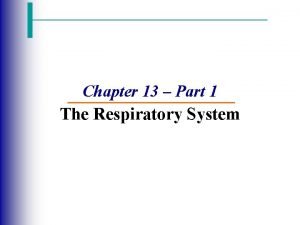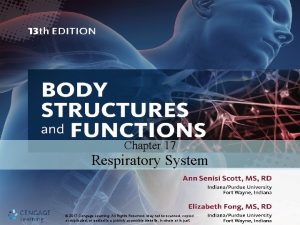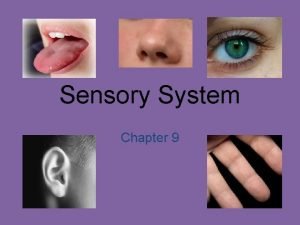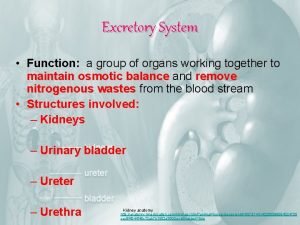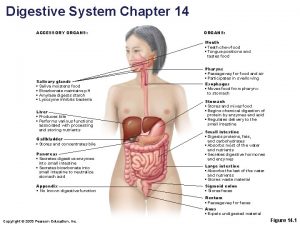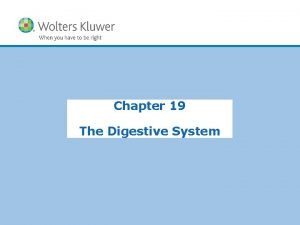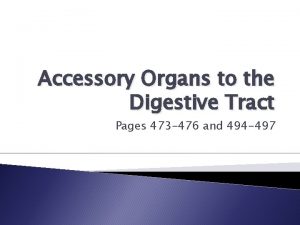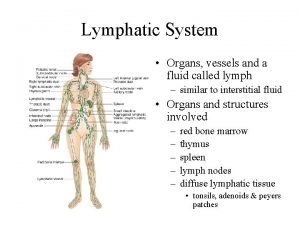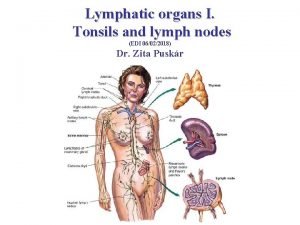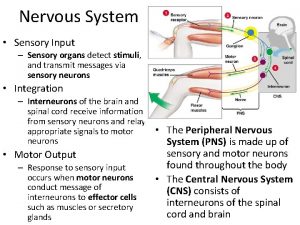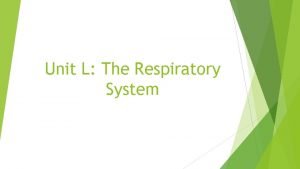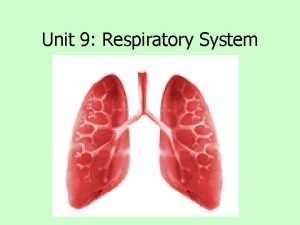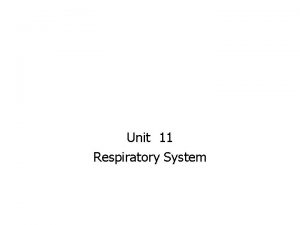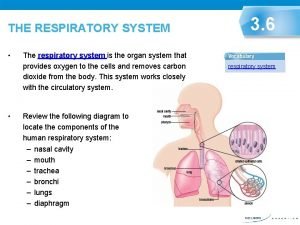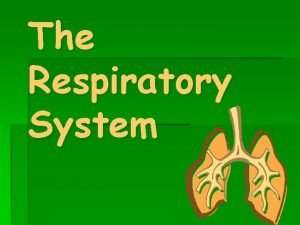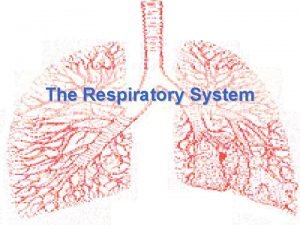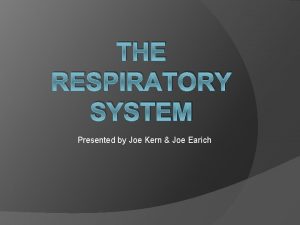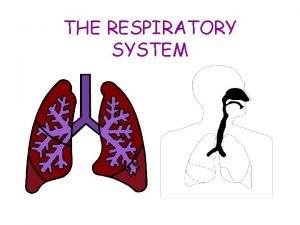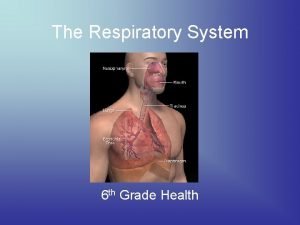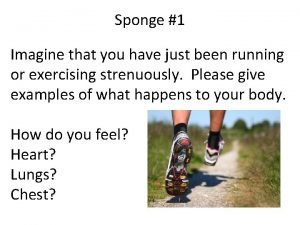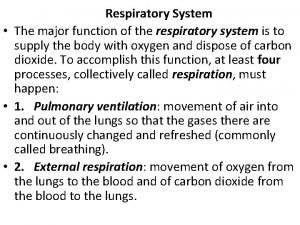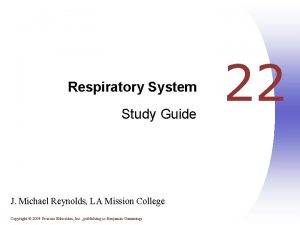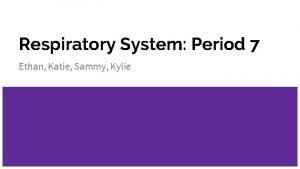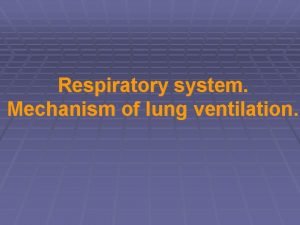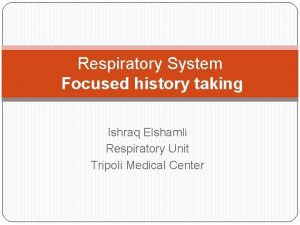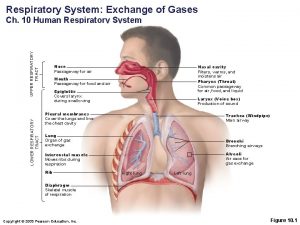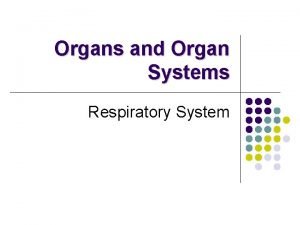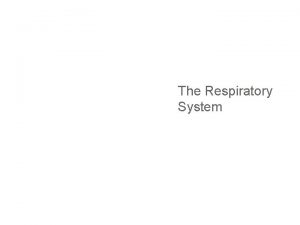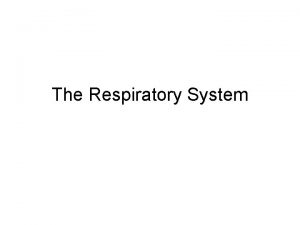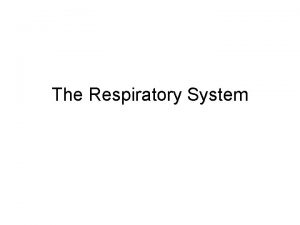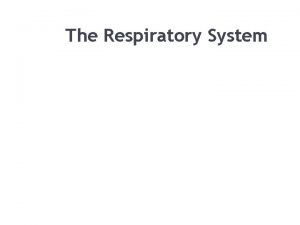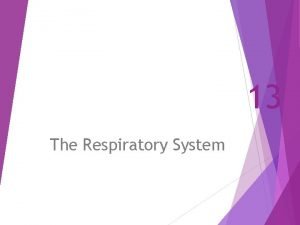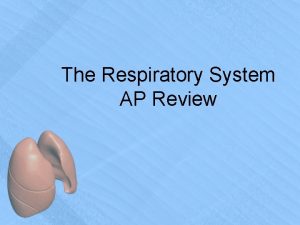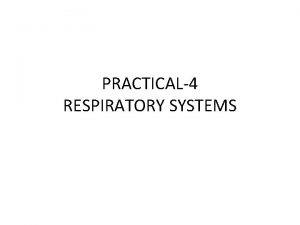The Respiratory System CHAPTER 13 Organs of the
















































- Slides: 48

The Respiratory System CHAPTER 13

Organs of the Respiratory system l Nose l Pharynx l Larynx l Trachea l Bronchi l Lungs – alveoli

Functions of the Respiratory System l Gas exchanges between the blood and external environment u Occurs in the alveoli of the lungs l Passageways to the lungs purify, humidify, and warm the incoming air

The Nose l Only externally visible part of the respiratory system l Consists of nasal bones, extensions of frontal and maxillary bones l Air enters the nose through the external nares (nostrils) l The interior of the nose consists of a nasal cavity u divided by a nasal septum

Anatomy of the Nasal Cavity l Olfactory receptors are located in the mucosa on the superior surface of nasal cavity l The rest of the cavity is lined with respiratory mucosa l Functions: Moistens air u Traps incoming foreign particles u

Anatomy of the Nasal Cavity l Lateral walls have projections called conchae u Increases surface area u Increases air turbulence within the nasal cavity l The nasal cavity is separated from the oral cavity by the palate u Anterior hard palate (bone) u Posterior soft palate (muscle)

Paranasal Sinuses l Cavities within bones surrounding the nasal cavity are called sinuses l Sinuses are located in the following bones u u Frontal bone Sphenoid bone Ethmoid bone Maxillary bone l Function of the sinuses u u u Lighten the skull Act as resonance chambers for speech Produce mucus that drains into the nasal cavity

Pharynx (Throat) l Muscular passage from nasal cavity to larynx l Three regions of the pharynx u Nasopharynx – superior region behind nasal cavity u Oropharynx – middle region behind mouth u Laryngopharynx – inferior region attached to larynx l The oropharynx and laryngopharynx are common passageways u for air and food

Structures of the Pharynx l Tonsils of the pharynx u Pharyngeal tonsil (adenoids) are located in the nasopharynx u Palatine tonsils are located in the oropharynx u Lingual tonsils are found at the base of the tongue

Larynx (Voice Box) l Routes air and food into proper channels l Plays a role in speech l Made of eight rigid hyaline cartilages u and a spoon-shaped flap of elastic cartilage (epiglottis)

Structures of the Larynx l Thyroid cartilage u u Largest hyaline cartilage Protrudes anteriorly (Adam’s apple) l Epiglottis u u u Superior opening of the larynx Routes food to the esophagus and air toward the trachea When swallowing, the epiglottis rises and forms a lid over the opening of the larynx

Structures of the Larynx l Vocal cords (vocal folds) u Vibrate with expelled air to create sound (speech) l Glottis – opening between vocal cords

l Connects larynx with bronchi, approx. 4 inch long tube l Lined with ciliated mucosa u Beat continuously in the opposite direction of incoming air u Expel mucus loaded with dust and other debris away from lungs to the throat l Walls are reinforced with C -shaped hyaline cartilage Trachea (Windpipe)

l Formed by division of the trachea l Enters the lung at the hilus (medial depression) l Right bronchus is wider, shorter, and straighter than left l Bronchi subdivide into smaller and smaller branches Primary Bronchi

Respiratory Tree Divisions l Primary bronchi l Secondary bronchi l Tertiary bronchi l Bronchioles l Terminal bronchioles l These passages are conducting zone

Respiratory Zone Terminal bronchioles branch into u Respiratory bronchioles u Alveolar ducts u Alveolar sacs u Alveoli (air sacs) u l Site of gas exchange = alveoli only

Lungs l Occupy most of the thoracic cavity Superior portion (apex) is near the clavicle u Base rests on the diaphragm (inferior portion) u u Each lung is divided into lobes by fissures • Left lung – two lobes • Right lung – three lobes

Lungs l Pulmonary (visceral) pleura covers the lung surface l Parietal pleura lines the walls of the thoracic cavity l Pleural cavity is filled with pleural fluid l Pleural fluid: acts as a lubricant and helps hold the two membranes close together

Respiratory Membrane (Air-Blood Barrier) l Alveolar walls are composed of thin layer of squamous epithelial cells l External surfaces of alveoli are covered by Pulmonary capillaries l On one side of the respiratory membrane is air and on the other side is blood flowing past

Gas Exchange l Gas exchange through respiratory membrane occurs by diffusion u u Oxygen enters the blood Carbon dioxide enters the alveoli l Alveolar macrophages provide protection by picking up bacteria, carbon particles, and other debris l Surfactant (a lipid molecule) coats alveolar surfaces l Surfactant lowers the surface tension of water film lining the alveolar sac, so alveoli do not collapse

Events of Respiration l Respiratory system supply the body oxygen and dispose of carbon dioxide l Respiration includes four process: l Pulmonary ventilation – movement of air into & out of the lungs (breathing) l External respiration – gas exchange between pulmonary blood and alveoli u Oxygen is loaded into the blood u CO 2 is unloaded from the blood l Respiratory gas transport – transport of O 2 from lungs to tissues via blood, CO 2 from tissue to lungs via blood l Internal respiration – gas exchange between blood and tissue cells in systemic capillaries

Mechanics of Breathing (Pulmonary Ventilation) l Two phases u Inspiration – flow of air into lung u Expiration – air leaving lung

Inspiratio n l Diaphragm and external intercostal muscles contract l The size of the thoracic cavity increases l External air is pulled into the lungs due to Increase in intrapulmonary volume u Decrease in gas pressure u

Expirati on l Largely a passive process which depends on natural lung elasticity l As muscles relax, air is pushed out of the lungs due to u u Decrease in thoracic and intrapulmonary volume Increase in gas pressure l Forced expiration can occur mostly by contracting internal intercostal muscles to depress the rib cage

Respiratory Volumes and Capacities l Normal breathing moves about 500 ml of air with each breath u Referred to as tidal volume [TV] l Many factors that affect respiratory capacity A person’s size u Sex u Age u Physical condition u

Respiratory Volumes and Capacities l Inspiratory reserve volume (IRV) u u Amount of air that can be taken in forcibly over the tidal volume Usually between 2100 and 3200 ml l Expiratory reserve volume (ERV) u u Amount of air that can be forcibly exhaled after tidal expiration Approximately 1200 ml l Residual volume u u Air remaining in lung after forceful expiration About 1200 ml

Respiratory Volumes and Capacities l Vital capacity u The total amount of exchangeable air, 4800 ml u Vital capacity = TV + IRV + ERV u Dead space volume • Air that remains in conducting zone and never reaches alveoli • About 150 ml

Respiratory Volumes and Capacities l Functional volume u Air that actually reaches the respiratory zone, contributes to gas exchange is usually about 350 ml l Respiratory capacities are measured with a spirometer

Respiratory Sounds l Sounds are monitored with a stethoscope l Bronchial sounds – u produced by air rushing through trachea and bronchi l Vesicular breathing sounds – u soft sounds of air filling alveoli

External Respiration l Oxygen loaded into the blood l The alveoli always has more oxygen than the blood u Oxygen moves by diffusion towards the area of higher conc. to lower conc. to capillary u Pulmonary capillary blood gains oxygen

External Respiration l Carbon dioxide unloaded out of the blood u Blood returning from tissues has higher concentrations of carbon dioxide than alveoli u CO 2 moves from capillaries to alveoli and flushed out of lungs during expiration l Blood leaving the lungs is oxygen- rich and carbon dioxide-poor

Gas Transport in the Blood l Oxygen is transported in the blood in two ways: u Most oxygen attached to hemoglobin in RBCs to form oxyhemoglobin (Hb. O 2) u A small dissolved amount of O 2 is carried in the plasma

Gas Transport in the Blood l Carbon dioxide transport in the blood u Most is transported in the plasma as bicarbonate ion (HCO 3–) u Conversion of CO 2 to bicarbonate ion takes place in RBCs then diffuse into plasma u A small amount of CO 2 is carried inside red blood cells on hemoglobin, but at different binding sites than those of oxygen

Internal Respiration l Exchange of gases between blood and tissue cells l An opposite reaction to what occurs in the lungs Carbon dioxide diffuses out of tissue to blood u Oxygen diffuses from blood into tissue u

Neural Regulation of Respiration l Activity of respiratory muscles, diaphragm and external intercoastals is transmitted to and from the brain by u the phrenic and intercostal nerves l medulla u regulates basic rhythm of respiration

Neural Regulation of Respiration l Pons l Fine tuning of respiratory rate l Normal respiratory rate (eupnea) is u 12– 15 respirations per minute l Hypernia is u u increased respiratory rate often due to extra oxygen needs Exercise

Respiratory Rate Changes Throughout Life l Newborns – 40 to 80 respirations per minute l Infants – 30 respirations per minute l Age 5 – 25 respirations per minute l Adults – 12 to 18 respirations per minute l Rate often increases somewhat with old age

Factors Influencing Respiratory Rate and Depth : physical and chemical factors Physical factors Increased body temperature u Exercise u Talking u Coughing u l Volition (conscious control): singing , swimming l Emotional factors: anxiety attack

Factors Influencing Respiratory Rate and Depth : physical and chemical factors Chemical factors u Carbon dioxide levels • Increased carbon dioxide increases respiration • Changes in carbon dioxide act directly on the medulla oblongata u Oxygen levels • Changes in oxygen concentration in the blood are detected by chemoreceptors in the aorta and carotid artery • Information is sent to the medulla oblongata

Respiratory disorders l COPD l Lung cancer l SIDS l Asthma l Cystic fibrosis

Chronic Obstructive Pulmonary Disease (COPD) chronic emphysema and bronchitis l Most victims retain carbon dioxide, are hypoxic and have respiratory acidosis u Those infected will ultimately develop respiratory failure u Labored breathing (dyspnea) becomes progressively more severe u Coughing and frequent pulmonary infections are common u Patients almost always have a history of smoking

Emphysema l Alveoli enlarge as adjacent chambers break through l Airways collapse during expiration

Chronic Bronchitis l Mucosa of the lower respiratory passages becomes severely inflamed l Pooled mucus impairs ventilation and gas exchange l Risk of lung infection increases

Lung Cancer l Accounts for 1/3 of all cancer deaths in the United States l Increased incidence associated with smoking l Tumors in the lungs

Sudden Infant Death syndrome (SIDS) l healthy infant stops breathing and dies during sleep l Some cases are thought to be a problem of the u neural respiratory control center l One third of cases appear to be due to u heart rhythm abnormalities

Asthma l Chronic inflamed hypersensitive bronchiole passages l Response to irritants with Dyspnea ( labored breathing), u coughing, and wheezing u

l Cystic fibrosis u over secretion of thick mucus u clogs the respiratory system

Aging Effects l Elasticity of lungs decreases l Vital capacity decreases l Blood oxygen levels decrease l Stimulating effects of carbon dioxide decreases l More risks of respiratory tract infection
 Which organs are involved in respiratory system
Which organs are involved in respiratory system Chapter 13 respiratory system
Chapter 13 respiratory system Conducting zone vs respiratory zone
Conducting zone vs respiratory zone Animal physiology
Animal physiology Respiratory organs of invertebrates
Respiratory organs of invertebrates Organs forming the respiratory passageway
Organs forming the respiratory passageway Upper respiratory tract organs
Upper respiratory tract organs Figure 13-2 respiratory system
Figure 13-2 respiratory system Digestive system respiratory system and circulatory system
Digestive system respiratory system and circulatory system How respiratory system work with circulatory system
How respiratory system work with circulatory system Circulatory system and respiratory system work together
Circulatory system and respiratory system work together The human respiratory system chapter 7 handout
The human respiratory system chapter 7 handout Respiratory tree divisions
Respiratory tree divisions Perfusion respiratory system
Perfusion respiratory system The parts of the respiratory system in order
The parts of the respiratory system in order Chapter 7 the respiratory system labeling exercises
Chapter 7 the respiratory system labeling exercises Chapter 34 section 2 the respiratory system
Chapter 34 section 2 the respiratory system Chapter 13 respiratory system figure 13-4
Chapter 13 respiratory system figure 13-4 Chapter 17 respiratory system workbook answers
Chapter 17 respiratory system workbook answers Sensory system organs
Sensory system organs What is the main function of the excretory system
What is the main function of the excretory system Function of mouth in digestive system
Function of mouth in digestive system Accessory organs of the digestive system
Accessory organs of the digestive system Accessory organ of the digestive system
Accessory organ of the digestive system Red and white blood cells difference
Red and white blood cells difference Lymphatic system organs
Lymphatic system organs Venule
Venule Largest lymphoid organ
Largest lymphoid organ Organs of the sensory system
Organs of the sensory system Chapter 16 matching questions 6-10
Chapter 16 matching questions 6-10 Respiratory system bozeman
Respiratory system bozeman Unit 9 respiratory system
Unit 9 respiratory system Diagnostic test of respiratory system
Diagnostic test of respiratory system Respiratory system
Respiratory system Voice box respiratory system
Voice box respiratory system Respiratory system coloring page
Respiratory system coloring page Respiratory system purpose
Respiratory system purpose Conclusion respiratory system
Conclusion respiratory system Jobs of the respiratory system
Jobs of the respiratory system Interesting facts about respiratory system
Interesting facts about respiratory system Imagine
Imagine What is the major function of the respiratory system
What is the major function of the respiratory system Respiratory system diagram unlabeled
Respiratory system diagram unlabeled Respiratory system vocabulary
Respiratory system vocabulary Gas exchange
Gas exchange Respiratory system maintain homeostasis
Respiratory system maintain homeostasis Conducting zone of the respiratory system function
Conducting zone of the respiratory system function Fever history taking
Fever history taking Upper and lower respiratory system
Upper and lower respiratory system
